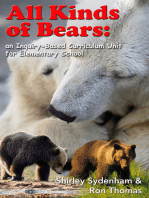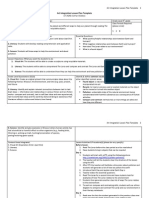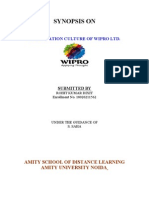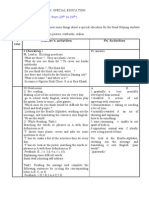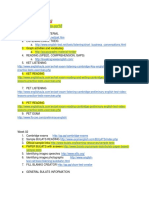Curriculum Map2013
Curriculum Map2013
Uploaded by
api-216592991Copyright:
Available Formats
Curriculum Map2013
Curriculum Map2013
Uploaded by
api-216592991Original Title
Copyright
Available Formats
Share this document
Did you find this document useful?
Is this content inappropriate?
Copyright:
Available Formats
Curriculum Map2013
Curriculum Map2013
Uploaded by
api-216592991Copyright:
Available Formats
Unit Title: Central Idea:
Sharing the Planet
nsQuestiorTeache Summative Assessment Choices people make can support conservation of the Earth.
Focus: Concepts:
PSPE, Science, Maths connection, perspective, reflection
Proposed Dates:
24th March 9th May
Objective: To identify a problem, implement an action plan, and reflect on its effectiveness. Audience: peers Product: Action plan accompanied by a reflection Success Students will identify problem, collect data, devise and implement action plan, and reflect on Indicator: effectiveness of action plan.
Inquiry Lines:
Conservation of the Earth Practices that promote conservation Our role and responsibility in promoting conservation Consequences of not conserving
What What What What
is conservation? are the strategies we use to conserve? are our roles and responsibilities in conserving? will the impact be if we don't conserve?
Focused learning opportunities and curriculum benchmarks being covered during unit Literacy: Reading
Students will continue to develop the following text types: Narrative: Evaluate illustrations, characters, main events, problem, resolution, language patterns in the following texts The Lorax, Unos Garden, The Tin Forest to highlight our Students will develop the following writing text types: - Exposition: use data collected on waste concern in our school and write a letter and/or design a poster to persuade school community to take action. Students will develop the following mathematical concepts: - Measurement: Mass/Capacity: - Measure the total weight of class waste daily for a week in non-standard standard Students will: - Investigate conservation using a variety of online resources such as Brainpop jr, espresso etc. Students will develop: Vocabulary related to our environment - Simple adjectives describing the environment Students will: - Continue to develop all musical skills, with an emphasis on connecting how note values create rhythmic patterns Students will: - Undertake a dance unit focussing on motif environmental responsibilities. -Information & Descriptive Reports : find out about the environment by exploring non-fiction text features: contents page, glossary, specific information, photographs, diagrams. - Information Report: write simple facts about how biodegradable and non- biodegradable waste effect the environment. - Use containers to measure the capacity of water wasted in milliliters-liters. Analyze data collected and discuss solutions. - Chance/Data: interpret and analyze class waste data into a graph. Which waste can be reused or recycled? -Use Microsoft PowerPoint to present information promoting conservation and their roles and responsibilities in conservation of the earth. - Write joining simple Arabic letters - Reading simple words in Arabic -Listening skills by matching picture to words called out. - Create rhythm with traditional notation and play rhythms on classroom instruments - Discuss the connection of movements learnt in gymnastics. -Procedural Text: follow directions on how to make/do something.
Ongoing
- Reading strategies to make meaning of text by making inferences, connections and finding important information. -Use word patterns to analyze words. -Use syllables to take words apart. - A range of strategies to spell high frequency words, long vowels and digraphs, blends. Commonly used punctuation; capitals, full stops, question marks. Skills of revising and editing their written work - Mathletics.com - Rainforest to reinforce number related concepts: Place Value, Number Patterns, Addition and Subtraction Space and Shape
Literacy: Writing
-Description : write describing how our school community will look like if its littered. -Narrative: rewrite The Lorax saving the Truffula tree forest and its inhabitants. - Sort and compare garbage collected from home according to its raw materials. Which raw material is consumed the most? What can we do to modify their behaviour at home? - Sort garbage according to recycle, compost, actual garbage. - Analyze food packaging and its negative effect
Math
ICT Arabic
- Skills to identify pictures and their matching words.
Music
- Explore and discover rhythms that are used in songs currently sung. - Learn more dance related vocabulary and skills such as motifs, the health and safety aspect of
P.E.
design using the stimulus of the Jack Johnson song - reflect on own and others performances Reduce, reuse, recycle Students will: - Create junk art: (re)using materials i.e. paper mache, plastic bags, card etc, to construct and make things such as masks, Students will: learn how NF books are put in order specifically environmental books picture frames, sculptures etc. Make painting and printing tools from recycled materials such as scrunched plastic or paper, or rollers from plastic bottles
The Arts Library Notes/Fi eld Trips
lifting, performance and audience etiquette and also evaluating and reflecting on performances to aid learning - Look at artists who use junk as art - Consider elements of art such as from and texture in their art - Mask Making Day with parents - Explore how books can be made into movies and difference seen between a book and its movie.
- Connect the Lorax with other Dr. Seuss books and reflect on personal prospection impacts the books we read Watch in the school auditorium The Lorax the movie based on Dr Seuss picture book .
You might also like
- Grade4 Science Waste in Our World Unit Plan 3Document11 pagesGrade4 Science Waste in Our World Unit Plan 3api-528469698No ratings yet
- English Syntax and Universal Grammar An Introduction To Syntactic AnalysisDocument317 pagesEnglish Syntax and Universal Grammar An Introduction To Syntactic AnalysisNho Thuan NguyenNo ratings yet
- Sharing The PlanetDocument4 pagesSharing The Planetapi-147600993100% (2)
- The Lorax Science LessonDocument4 pagesThe Lorax Science Lessonapi-254295591100% (1)
- Sharingtheplanet 8-12upDocument4 pagesSharingtheplanet 8-12upapi-147600993No ratings yet
- The Lorax Lesson PlanDocument11 pagesThe Lorax Lesson Planapi-235734674100% (1)
- Modules 1-10: Volver A La Semana 6Document10 pagesModules 1-10: Volver A La Semana 6Juan ToralNo ratings yet
- KGutierrez Lessons April 24Document13 pagesKGutierrez Lessons April 24Kimberly GutierrezNo ratings yet
- Unit 3 LetterDocument5 pagesUnit 3 Letterapi-237760840No ratings yet
- Sharing The Planet Parent LetterDocument7 pagesSharing The Planet Parent Letterapi-240369918100% (1)
- World Food DayDocument87 pagesWorld Food DayScribdTranslationsNo ratings yet
- KGutierrez Lessons May 29Document11 pagesKGutierrez Lessons May 29Kimberly GutierrezNo ratings yet
- Natural Resources: What They Are and How We Use ThemDocument5 pagesNatural Resources: What They Are and How We Use ThemTim HerberNo ratings yet
- April15-19 Lessons 2024 Cycle 3Document25 pagesApril15-19 Lessons 2024 Cycle 3Erlinda CalNo ratings yet
- Unit 3 Letter How The World Works kg2Document5 pagesUnit 3 Letter How The World Works kg2api-265159101100% (1)
- April 22 - April 26 Lessons Cycle 3 2024Document19 pagesApril 22 - April 26 Lessons Cycle 3 2024Erlinda CalNo ratings yet
- g4 How The World Works Curriculum MapDocument2 pagesg4 How The World Works Curriculum Mapapi-236408805No ratings yet
- NBS Learning Scenario Template For MOOC (Maria Mantelou)Document7 pagesNBS Learning Scenario Template For MOOC (Maria Mantelou)Kamil Paşa İlkokuluNo ratings yet
- Rainforest Lesson PlanDocument7 pagesRainforest Lesson Planapi-609136962No ratings yet
- Grade 5 Udl Unit Plan RevDocument10 pagesGrade 5 Udl Unit Plan Revapi-203221125No ratings yet
- Art Integration Lesson Plan Template: (Please Circle)Document5 pagesArt Integration Lesson Plan Template: (Please Circle)api-302379773No ratings yet
- Lesson Plan Science Wood - NonaDocument4 pagesLesson Plan Science Wood - Nonaapi-281024651No ratings yet
- Webbing Group AssignmentDocument2 pagesWebbing Group Assignmentapi-122605596No ratings yet
- Stages in A Reading Lesson PlanDocument54 pagesStages in A Reading Lesson PlanSally Nair100% (13)
- RPP Kls X Recount TextDocument7 pagesRPP Kls X Recount TextRinaAstutiNo ratings yet
- 4 Mat Wet Dry Environ 2Document7 pages4 Mat Wet Dry Environ 2api-198669584No ratings yet
- PK 3readfortherecordDocument22 pagesPK 3readfortherecordapi-348359974No ratings yet
- Raymond Kallie-Lessonplan1finalDocument4 pagesRaymond Kallie-Lessonplan1finalapi-706959969No ratings yet
- The Red Sash SequenceDocument5 pagesThe Red Sash Sequencekim_wedman100% (1)
- g5 English News Letter - How The World WorksDocument2 pagesg5 English News Letter - How The World Worksapi-269131865No ratings yet
- Lesson Plan 1Document3 pagesLesson Plan 1api-425043985No ratings yet
- Phase 3 Draft 4Document1 pagePhase 3 Draft 4api-299706386No ratings yet
- How The World WorksDocument3 pagesHow The World Worksapi-250808296100% (1)
- Amazon Rainforest PresentationDocument21 pagesAmazon Rainforest Presentationapi-256807595No ratings yet
- Grade 7 Interdisciplinary Unit ChartDocument3 pagesGrade 7 Interdisciplinary Unit Chartapi-299824541No ratings yet
- Guided Reading Lesson Green Day 7 w2Document3 pagesGuided Reading Lesson Green Day 7 w2api-199099982No ratings yet
- g4 How The World Works Curriculum MapDocument4 pagesg4 How The World Works Curriculum Mapapi-293372263No ratings yet
- Instructional Strategies and Learning TasksDocument4 pagesInstructional Strategies and Learning Tasksapi-280361688No ratings yet
- What Does Nature Teach UsDocument26 pagesWhat Does Nature Teach Usapi-430097640No ratings yet
- How Tall Am I Lesson PlanDocument4 pagesHow Tall Am I Lesson Planapi-349980598No ratings yet
- G2 Overview - How The World WorksDocument3 pagesG2 Overview - How The World Worksbriony_venhoekNo ratings yet
- Uoi 3 Parent LetterDocument7 pagesUoi 3 Parent Letterapi-265511182No ratings yet
- Humanimpact SustainablefuturesDocument8 pagesHumanimpact Sustainablefuturesapi-285311506No ratings yet
- Lesson 7 Outsiders CH 5Document14 pagesLesson 7 Outsiders CH 5api-349579702No ratings yet
- Research PaperDocument12 pagesResearch PaperRachel Alex0% (1)
- Itec 7400 El Draft Template Su2013Document6 pagesItec 7400 El Draft Template Su2013api-324404399No ratings yet
- Itec 7400 El Draft Template Su2013Document6 pagesItec 7400 El Draft Template Su2013api-324404399No ratings yet
- Lesson Three - HillsDocument3 pagesLesson Three - Hillsapi-283707491No ratings yet
- Art Integrated Lesson PlanDocument5 pagesArt Integrated Lesson Planapi-248641854100% (1)
- Unit 4 - Lessons - 6-10 (Pp. 198-205)Document8 pagesUnit 4 - Lessons - 6-10 (Pp. 198-205)catherinerenante100% (1)
- Saturday Art - Lesson Plan Animals in Their HabitatsDocument5 pagesSaturday Art - Lesson Plan Animals in Their Habitatsapi-264233549No ratings yet
- Montenegro Final VersionDocument4 pagesMontenegro Final VersionShafiq HawamdaNo ratings yet
- BTW Design FinalDocument7 pagesBTW Design Finalapi-242356907No ratings yet
- 5 History Lesson DeruiterDocument4 pages5 History Lesson Deruiterapi-337281159No ratings yet
- Just A Little Bit Lesson PlanDocument4 pagesJust A Little Bit Lesson Planapi-285060895No ratings yet
- National Parks Thematic UnitDocument13 pagesNational Parks Thematic Unitapi-497358383No ratings yet
- Recycling Campaign Lesson Plan: Audience: 8Document2 pagesRecycling Campaign Lesson Plan: Audience: 8api-377802356No ratings yet
- Are You An Artist?: WhenDocument1 pageAre You An Artist?: Whenapi-216592991No ratings yet
- g2 Newsletterhow The Worldworks 2014 2-15Document2 pagesg2 Newsletterhow The Worldworks 2014 2-15api-216592991No ratings yet
- g2 Newsletterhow The Worldworks 2014Document1 pageg2 Newsletterhow The Worldworks 2014api-216592991No ratings yet
- Subjecttimetable 2 RBDocument1 pageSubjecttimetable 2 RBapi-216592991No ratings yet
- Grade 1Document1 pageGrade 1api-216592991No ratings yet
- 3 Vocabulary - UsageDocument92 pages3 Vocabulary - UsageJainam SoniNo ratings yet
- GROUP 5 - Detailed Lesson Plan For Grade 8 EnglishDocument8 pagesGROUP 5 - Detailed Lesson Plan For Grade 8 EnglishAira SerranoNo ratings yet
- Aman Bhaiya ResumeDocument3 pagesAman Bhaiya ResumeASHUTOSH PRATAP SINGHNo ratings yet
- Matrix For Journal ArticlesDocument11 pagesMatrix For Journal Articlesnorma thamrinNo ratings yet
- Hotel Industry: Marriott InternationalDocument3 pagesHotel Industry: Marriott InternationalSAGI MANISHANo ratings yet
- Application of Artificial Intelligence AI in FoodDocument8 pagesApplication of Artificial Intelligence AI in FoodMarwa ARNo ratings yet
- Lesson Plan ScenarioDocument2 pagesLesson Plan Scenarioapi-247663890No ratings yet
- Community and Public Health Nursing, 2nd EditionDocument2 pagesCommunity and Public Health Nursing, 2nd EditionHimantha Damindupriya Wickramasinghe40% (5)
- Organization Culture of Wipro LTDDocument16 pagesOrganization Culture of Wipro LTDSaikat Saha50% (6)
- Annotated Lesson Plan - GreeceDocument3 pagesAnnotated Lesson Plan - Greeceapi-212189137No ratings yet
- Unit 4Document9 pagesUnit 4thai_nhhNo ratings yet
- LESSON PLAN 1 G1+G2 AnimalsDocument2 pagesLESSON PLAN 1 G1+G2 AnimalsMinato YOndaimeNo ratings yet
- Gramata (2015) - Benefits of Chamber Music ParticipationDocument78 pagesGramata (2015) - Benefits of Chamber Music ParticipationLuis Varela CarrizoNo ratings yet
- Music Makes You SmarterDocument9 pagesMusic Makes You SmarterkajsdkjqwelNo ratings yet
- Reported Speech (JNV)Document3 pagesReported Speech (JNV)robidad705No ratings yet
- Module 2 Lesson 2 - CADDocument8 pagesModule 2 Lesson 2 - CADMaryvic Bilan BusquitNo ratings yet
- Philosophy of LoveDocument2 pagesPhilosophy of Loveantonio100% (1)
- Links To MaterialsDocument2 pagesLinks To Materialstef317No ratings yet
- Grade 10-Learning Activity Sheet Q4M3Document3 pagesGrade 10-Learning Activity Sheet Q4M3Elsa T. HilarioNo ratings yet
- Questioning Techniques: Research-Based Strategies For TeachersDocument4 pagesQuestioning Techniques: Research-Based Strategies For TeachersEstella CantiNo ratings yet
- Role Play 1: "BRAIN DRAIN": SituationDocument1 pageRole Play 1: "BRAIN DRAIN": SituationParaschiv GheorgheNo ratings yet
- Contextual Learning Matrix TemplateDocument2 pagesContextual Learning Matrix TemplateKaren Mae AlagosNo ratings yet
- Creative Writing Module 1 ImageryDocument15 pagesCreative Writing Module 1 ImageryAngela Mae CañoNo ratings yet
- (Signaure) RESUME P.vineeth S/o Ashokkumar, D.No.1-1/6-39,4F, B-52, Lotus Legend Appartments, Opp Neelima Theatre, Kummaripallem Center, Vidyadharapuram, VijayawadaDocument2 pages(Signaure) RESUME P.vineeth S/o Ashokkumar, D.No.1-1/6-39,4F, B-52, Lotus Legend Appartments, Opp Neelima Theatre, Kummaripallem Center, Vidyadharapuram, VijayawadaRamya CherukuneediNo ratings yet
- Sample IntroductionDocument4 pagesSample IntroductionMa. Aiza SantosNo ratings yet
- Serengeti Safari AdventureDocument4 pagesSerengeti Safari Adventuresherri robertsNo ratings yet
- PWC Tanzania InternshipDocument2 pagesPWC Tanzania InternshipHannahNo ratings yet
- Language (50 Marks) 21 - 25 16 - 20 11 - 15 6 - 10 1 - 5: Revised Written Report Scoring RubricDocument3 pagesLanguage (50 Marks) 21 - 25 16 - 20 11 - 15 6 - 10 1 - 5: Revised Written Report Scoring Rubricsilent spritsNo ratings yet

















